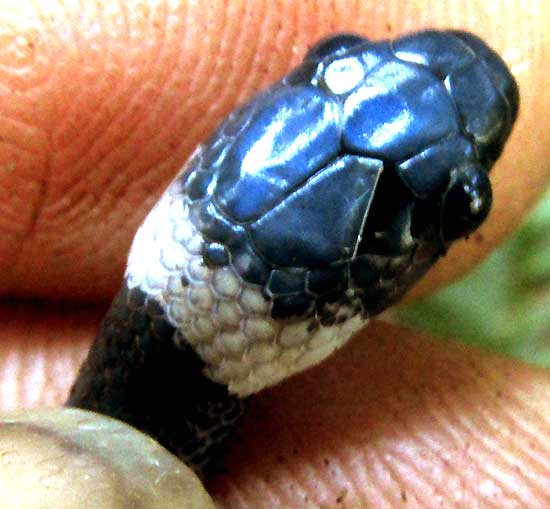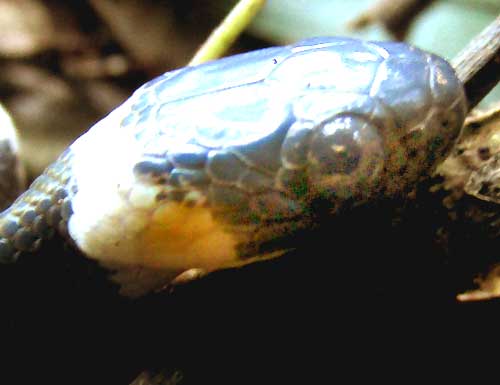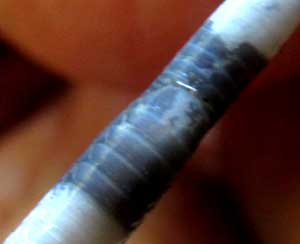Excerpts from Jim Conrad's
Naturalist Newsletter
issued September 22, 2019 from near the forest just west of Tepakán; elev. ~9m (~30 ft), N21.053°, W89.052°; north-central Yucatán state, MÉXICO
SHORT-FACED SNAIL-EATER
While clearing a trail through the rancho's regenerating thorn-forest, with my toe I nudged aside some leaflitter, uncovering the 10-inch-long (25cm) snake shown below:

Twice before I've met this species {following entries} -- it's the Short-faced Snail-eater, DIPSAS BREVIFACIES -- but both times it was roadkill not bearing taking too close a look at. This time I was happy to have a live one. And a more docile creature I couldn't have asked for, never trying to bite and only reasonably trying to escape. Note that in the above picture the black bands display a certain silvery sheen, or "glaucescence." On the deeply shaded forest floor, the sheen was even more prominent. This is a feature I'd not noted before on the dead ones. This one's head was in a good shape, so I photographed the scale pattern atop its head, always important for definitive identifications:

In the dim light, my shot of the side of the head didn't turn out so well, but that's it below, anyway:

And below you can see that the species has undivided anal scales:

More info on the species is provided below
from the November 24, 2008 Newsletter written in Yokdzonot about half an hour by bus west of Pisté, Yucatán, México
elevation ~25m (~82 ft), N20.707°, W88.731°
ROADKILL SNAIL-EATER
On the road to Mexil I found the roadkill-snake shown below.

Even though the critter was only about 15 inches long (38 cm) and looked dead as could be, my heart skipped a couple of beats. Part of that was the automatic response any normal human feels when nearly stepping on a snake, but part was that this snake definitely puts you in the mind of "coral snake," which isn't a kind of snake you want to fool with.
We have several snake species here who mimic venomous coral snakes, and this is one of them. Similarities include the bold banding, the blunt head hardly differentiated in size from the rest of the body, and the black snout and forehead. The most obvious feature separating this snake from real corals is that it is predominantly black, while the coral snakes' black bands are much narrower on predominantly red bodies. Other more technical and dependable differences can be noted -- this snake has nine or ten supralabial (above-the- lip) scales while corals have seven, for instance -- but my experience is that when you have a coral or a look-alike before you, doing something like counting scales above the critter's lip gets hard.
My roadkill was the Short-faced Snail-eater, DIPSAS BREVIFACIES, a nocturnal snake who eats snails, which it somehow extracts from their shells before swallowing them. It's limited in distribution to the northern Yucatán Peninsula, including east-central Belize and specializes in tropical dry forest habitats.
from the February 25, 2018 Newsletter issued from Rancho Regensis north of Valladolid, Yucatán, MÉXICO;
elevation ~40m (~130 ft), N~20.876°, W~88.170°
SNAIL-EATER WITH ALMOST WHITE BARS
During my Sunday bikeride to Temozón to buy bananas I came upon the foot-long snake shown below:

It was dead, either roadkill, or someone with a machete chopping weeds along the road had killed it, and posed it on the asphalt exactly where bikers would have to swerve to miss it. Lots of farmers bike that road, going to their isolated ranchos.
Interestingly, last July in about the same spot along the road to Temozón we also came upon a dead, possibly posed, and similar looking Ringed Snail-eater, whom you can compare with our current Short-faced Snail-eater at www.backyardnature.net/mexnat/snaileat.htm
It's tempting to wonder whether these may not be just variations of a single species, but the experts say they're different, even assign them to different genera, the Ringed species being the genus Sibon while the Short-faced is in Dipsas.
Our present Short-faced species is endemic just to the northern Yucatán Peninsula, including east-central Belize, and inhabits tropical dry forest habitats.
Jonathan Campbell in his Amphibians and Reptiles of Northern Guatemala, the Yucatán, and Belize remarks that the species is nocturnal and is most active on rainy nights. We haven't had rain for weeks, so I'm guessing that our recent heavy morning dews have encouraged snails to roam about, with snail-eaters after them.
Campbell also points out that the Short-faced Snail-eater displays many adaptations associated with arboreal snakes, including a laterally compressed and elongated body, an abrupt narrowing of the neck behind the head, and enlarged and protruding eyes, yet it's often found on the ground.
When this snake eats a snail, it first extracts it from its shell before swallowing it.